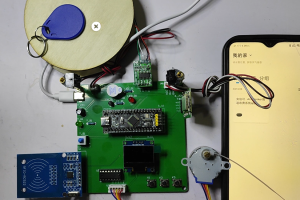设计说明书
总字数:20000+
摘要
随着高速公路车流量的不断增长,传统人工收费方式存在效率低、易拥堵、计费精准度不足等问题,难以满足现代交通对高效通行与智能化管理的需求。同时,车辆超载、逃费、长时间滞留等情况,不仅影响道路通行效率,还可能引发交通安全隐患,对高速公路运营管理造成挑战。因此,研发一种集称重检测、自动收费、智能管控于一体的 RFID 高速收费系统,对提升高速通行效率、保障道路安全、实现智能化运营具有重要意义。
本设计提出了一种基于 STM32F103C8T6 单片机的 RFID 高速收费系统。系统主要功能包括:通过 HX711 模块对车辆进行称重,支持小车(1kg 以内)、货车(2kg 以内)两个分区(用户通过按键选择车型),若车辆超重则禁止上高速,同时触发声光报警;借助 RFID-RC522 模块实现刷卡缴费,刷卡后通过 ULN2003A 驱动四相步进电机控制闸杆自动抬起,搭配分离式红外对管实现防追杆功能,仅当前车完全通过后闸杆才自动落下;刷卡成功后系统启动时间计费,按小车 1 元 / 分钟、货车 2 元 / 分钟的标准计算费用;若车辆长时间滞留高速未驶出,系统自动报警提示值班人员排查;用户通过按键可设置超载值、计费单价、滞留时长等阈值;通过 OLED 显示屏实时显示称重数据、车型、计费时长、费用、报警状态等信息;利用 ESP8266-12F WiFi 模块,将称重、计时、收费、警报等数据发送至手机端,实现远程监控与数据查看。
该 RFID 高速收费系统的作用在于,为高速公路运营提供了一种高效、精准、智能化的收费管理方案。通过自动称重与超载预警,可减少超载车辆对道路的损害,降低安全风险;自动刷卡与闸杆控制大幅提升通行效率,缓解收费口拥堵;实时计费与远程数据监控,便于运营方精准管理与异常排查,同时为用户提供透明、便捷的缴费体验,推动高速公路收费管理向智能化、数字化转型。
关键词:STM32 单片机;RFID 高速收费系统;称重检测;自动计费;远程监控
Design of RFID high-speed toll collection system based on microcontroller
Abstract
With the continuous growth of highway traffic volume, traditional manual toll collection methods have problems such as low efficiency, easy congestion, and insufficient billing accuracy, which are difficult to meet the needs of modern transportation for efficient passage and intelligent management. At the same time, situations such as vehicle overloading, fare evasion, and prolonged delays not only affect road traffic efficiency, but may also pose traffic safety hazards, posing challenges to the operation and management of highways. Therefore, developing an RFID high-speed toll collection system that integrates weighing detection, automatic toll collection, and intelligent control is of great significance for improving high-speed traffic efficiency, ensuring road safety, and achieving intelligent operation.
This design proposes an RFID high-speed toll collection system based on STM32F103C8T6 microcontroller. The main functions of the system include: weighing the vehicle through the HX711 module, supporting two zones for small cars (within 1kg) and trucks (within 2kg) (users can select the vehicle model by pressing the button). If the vehicle is overweight, it is prohibited from going on the highway and an audible and visual alarm is triggered; With the help of the RFID-RC522 module, card swiping payment is achieved. After swiping the card, the ULN2003A drives a four phase stepper motor to control the automatic lifting of the brake lever, and the separated infrared tube is used to achieve the anti chasing function. Only when the current vehicle completely passes through the rear brake lever will it automatically fall down; After successful card swiping, the system will start charging based on the standard of 1 yuan/minute for small cars and 2 yuan/minute for trucks; If the vehicle is stuck on the highway for a long time without driving out, the system will automatically sound an alarm to prompt the on duty personnel to investigate; Users can set thresholds such as overload value, billing unit price, and detention time by pressing buttons; Real time display of weighing data, vehicle model, billing duration, cost, alarm status and other information through OLED display screen; Using ESP8266-12F WiFi module, send weighing, timing, billing, alarm and other data to mobile devices for remote monitoring and data viewing.
The function of this RFID high-speed toll collection system is to provide an efficient, accurate, and intelligent toll management solution for highway operations. Through automatic weighing and overload warning, the damage caused by overloaded vehicles to the road can be reduced, and safety risks can be lowered; Automatic card swiping and gate control greatly improve traffic efficiency and alleviate congestion at toll gates; Real time billing and remote data monitoring facilitate precise management and abnormal investigation by operators, while providing users with a transparent and convenient payment experience, promoting the intelligent and digital transformation of highway toll management.
Keywords:STM32 microcontroller; RFID high-speed toll collection system; Weighing and testing; Automatic billing; remote monitoring
目 录
1 绪论
1.1 研究背景及意义
1.2 国内外研究现状
1.3 主要内容
2 系统总体方案设计
2.1系统总体设计
2.2 主要模块方案选择
3 系统硬件设计
3.1 总体硬件框架
3.2 主控模块电路设计
3.3 称重模块电路设计
3.4 RFID 刷卡模块电路设计
3.5 红外对管模块电路设计
3.6 步进电机驱动模块电路设计
3.7 按键模块电路设计
3.8 声光报警模块电路设计
3.9 显示模块电路设计
3.10 WiFi 模块电路设计
4 系统程序设计
4.1 编程软件介绍
4.2 系统主流程设计
4.3 独立按键
4.4 步进电机子流程设计
4.5 OLED显示流程设计
4.6 WiFi模块子流程设计
4.7 声光报警模块子流程设计
4.8 红外对射模块子流程设计
4.9 称重模块子流程设计
4.10 RFID模块子流程设计
5 实物制作与功能测试
5.1 实物制作
5.2 称重与超载报警功能测试
5.3 RFID 刷卡与闸杆控制功能测试
5.4 计时计费功能测试
5.5 超时滞留报警功能测试
5.6 阈值设置功能测试
5.7 OLED 显示功能测试
5.8 WiFi 数据传输功能测试
6 总结
参考文献
致谢
附录A 原理图
附录B PCB
附录C 主程序
购买后可查看具体内容!

